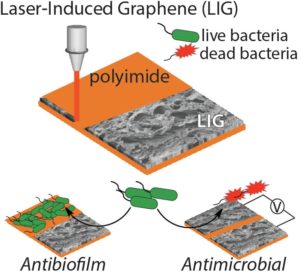
Electrified Graphene Is Bad News for Bacteria
Electrified Graphene Is Bad News for Bacteria
May 24, 2017
Desert & Water Research, Natural Sciences
Scientists at Ben-Gurion University of the Negev, Israel and Rice University, Houston have discovered that laser-induced graphene (LIG) is a highly effective anti-fouling material and, when electrified, bacteria zapper.
 LIG is a spongy version of graphene — the single-atom layer of carbon atoms — developed three years ago by Rice University chemist, Dr. James Tour, by burning partway through an inexpensive polyimide sheet with a laser, which turned the surface into a lattice of interconnected graphene sheets.
LIG is a spongy version of graphene — the single-atom layer of carbon atoms — developed three years ago by Rice University chemist, Dr. James Tour, by burning partway through an inexpensive polyimide sheet with a laser, which turned the surface into a lattice of interconnected graphene sheets.
Uses for this material include wearable electronics and fuel cells, and for superhydrophobic or superhydrophilic surfaces. When used as electrodes with a small applied voltage, LIG becomes the bacterial equivalent of a backyard bug zapper.
Tests without the charge confirmed what has long been known: graphene-based nanoparticles have antibacterial properties. When 1.1 to 2.5 volts were applied, the highly conductive LIG electrodes greatly enhanced those properties.
Dr. Christopher Arnusch, a lecturer at BGU’s Zuckerberg Institute for Water Research, specializes in water purification. His lab recently tested LIG electrodes in a bacteria-laden solution with 10 percent secondary treated wastewater and found that after nine hours at 2.5 volts, 99.9 percent of the bacteria were killed and the electrodes strongly resisted biofilm formation. Biofouling is the buildup of microorganisms, plants or other biological material on wet surfaces.
The researchers suspect bacteria may meet their demise through a combination of contact with the rough surface of LIG, the electrical charge and toxicity from localized production of hydrogen peroxide. The contact may be something like a knee hitting pavement, but in this case, the bacteria are all knee and the sharp graphene edges quickly destroy their membranes.
“This form of graphene is extremely resistant to biofilm formation, which has promise for places like water-treatment plants, oil-drilling operations, hospitals, and ocean applications like underwater pipes that are sensitive to fouling,” says Dr. Tour. “The antibacterial qualities when electricity is applied is a great additional benefit.”
The lead authors of the paper, published in the American Chemical Society’s Applied Materials and Interfaces, are Swatantra Singh, a postdoctoral fellow at BGU’s Zuckerberg Institute for Water Research, and Yilun Li, a graduate student at Rice. In addition to Drs. Tour and Arnusch, co-authors are BGU’s Dr. Avraham Be’er, the Roy J. Zuckerberg Career Development Chair for Water Research, and Prof. Emeritus Yoram Oren of the Zuckerberg Institute.




